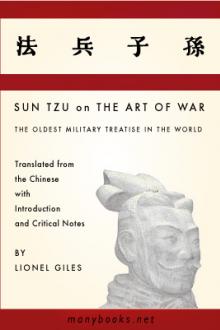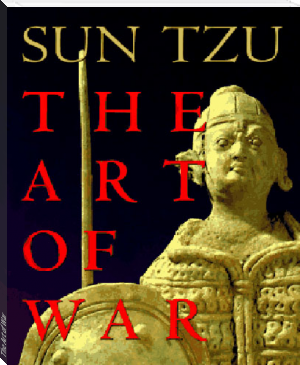The Art of War, Zi Sun [best book recommendations TXT] 📗

- Author: Zi Sun
- Performer: 0976072696
Book online «The Art of War, Zi Sun [best book recommendations TXT] 📗». Author Zi Sun
[It is not easy to distinguish the four terms very clearly in the Chinese. The first seems to be surveying and measurement of the ground, which enable us to form an estimate of the enemy's strength, and to make calculations based on the data thus obtained; we are thus led to a general weighing-up, or comparison of the enemy's chances with our own; if the latter turn the scale, then victory ensues. The chief difficulty lies in third term, which in the Chinese some commentators take as a calculation of NUMBERS, thereby making it nearly synonymous with the second term. Perhaps the second term should be thought of as a consideration of the enemy's general position or condition, while the third term is the estimate of his numerical strength. On the other hand, Tu Mu says: "The question of relative strength having been settled, we can bring the varied resources of cunning into play." Ho Shih seconds this interpretation, but weakens it. However, it points to the third term as being a calculation of numbers.]
19. A victorious army opposed to a routed one, is as a pound's weight placed in the scale against a single grain.
[Literally, "a victorious army is like an I (20 oz.) weighed against a SHU (1/24 oz.); a routed army is a SHU weighed against an I." The point is simply the enormous advantage which a disciplined force, flushed with victory, has over one demoralized by defeat." Legge, in his note on Mencius, I. 2. ix. 2, makes the I to be 24 Chinese ounces, and corrects Chu Hsi's statement that it equaled 20 oz. only. But Li Ch`uan of the T`ang dynasty here gives the same figure as Chu Hsi.]
20. The onrush of a conquering force is like the bursting of pent-up waters into a chasm a thousand fathoms deep.
————————————————————————————————-
V. ENERGY1. Sun Tzu said: The control of a large force is the same principle as the control of a few men: it is merely a question of dividing up their numbers.
[That is, cutting up the army into regiments, companies, etc., with subordinate officers in command of each. Tu Mu reminds us of Han Hsin's famous reply to the first Han Emperor, who once said to him: "How large an army do you think I could lead?" "Not more than 100,000 men, your Majesty." "And you?" asked the Emperor. "Oh!" he answered, "the more the better."]
2. Fighting with a large army under your command is nowise different from fighting with a small one: it is merely a question of instituting signs and signals. 3. To ensure that your whole host may withstand the brunt of the enemy's attack and remain unshaken - this is effected by maneuvers direct and indirect.
[We now come to one of the most interesting parts of Sun Tzu's treatise, the discussion of the CHENG and the CH`I." As it is by no means easy to grasp the full significance of these two terms, or to render them consistently by good English equivalents; it may be as well to tabulate some of the commentators' remarks on the subject before proceeding further. Li Ch`uan: "Facing the enemy is CHENG, making lateral diversion is CH`I. Chia Lin: "In presence of the enemy, your troops should be arrayed in normal fashion, but in order to secure victory abnormal maneuvers must be employed." Mei Yao-ch`en: "CH`I is active, CHENG is passive; passivity means waiting for an opportunity, activity beings the victory itself." Ho Shih: "We must cause the enemy to regard our straightforward attack as one that is secretly designed, and vice versa; thus CHENG may also be CH`I, and CH`I may also be CHENG." He instances the famous exploit of Han Hsin, who when marching ostensibly against Lin- chin (now Chao-i in Shensi), suddenly threw a large force across the Yellow River in wooden tubs, utterly disconcerting his opponent. [Ch`ien Han Shu, ch. 3.] Here, we are told, the march on Lin-chin was CHENG, and the surprise maneuver was CH`I." Chang Yu gives the following summary of opinions on the words: "Military writers do not agree with regard to the meaning of CH`I and CHENG. Wei Liao Tzu [4th cent. B.C.] says: 'Direct warfare favors frontal attacks, indirect warfare attacks from the rear.' Ts`ao Kung says: 'Going straight out to join battle is a direct operation; appearing on the enemy's rear is an indirect maneuver.' Li Wei-kung [6th and 7th cent. A.D.] says: 'In war, to march straight ahead is CHENG; turning movements, on the other hand, are CH`I.' These writers simply regard CHENG as CHENG, and CH`I as CH`I; they do not note that the two are mutually interchangeable and run into each other like the two sides of a circle [see infra, ss. 11]. A comment on the T`ang Emperor T`ai Tsung goes to the root of the matter: 'A CH`I maneuver may be CHENG, if we make the enemy look upon it as CHENG; then our real attack will be CH`I, and vice versa. The whole secret lies in confusing the enemy, so that he cannot fathom our real intent.'" To put it perhaps a little more clearly: any attack or other operation is CHENG, on which the enemy





Comments (0)